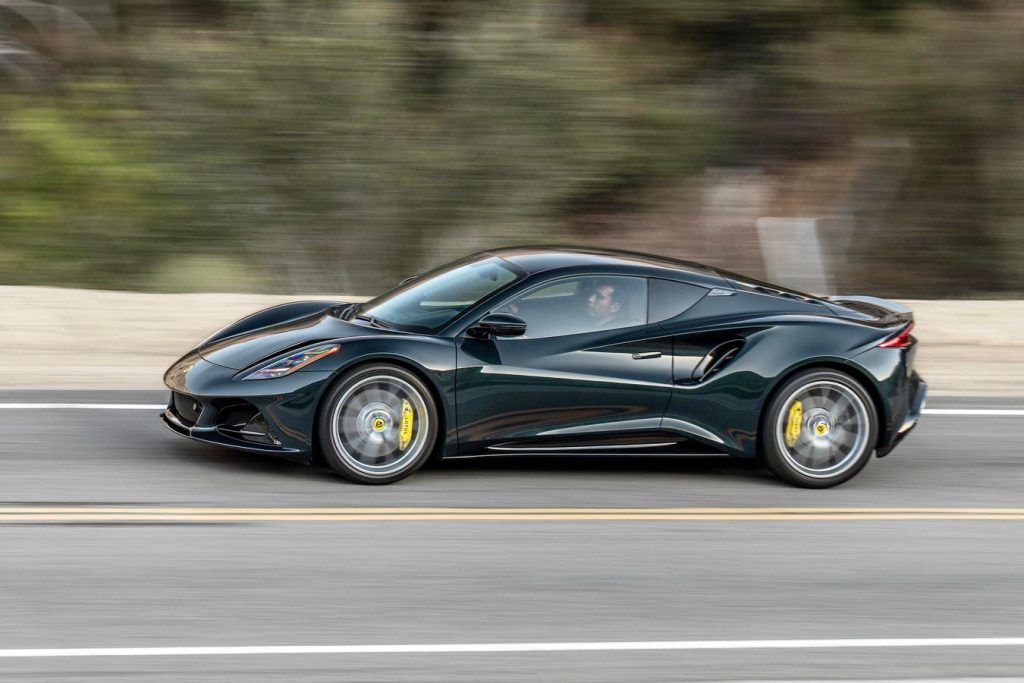After a long delay, the first Lotus Emira cars for visitors began to proliferate on American public roads. But only eagle-eyed Lotus enthusiasts will know the difference between the other optional packages available for the Emira First Edition: the choice between a supercharged V6 paired with a manual transmission or a turbocharged inline four-cylinder AMG with a dual-clutch automatic, and then suspension and Tour or Sport tire packages.
I recently tested an Emira with an AMG engine and sports suspension, having experimented with a Tour-spec manual V6 almost two years earlier. And surprisingly, the small turbo four-cylinder with automatic transmission inspired me as the best mix to tune the Emira. Sports chassis.
The engine itself makes 400 horsepower and 354 pound-feet of torque, at least here in America. However, that horsepower figure can cause some confusion. First of all, in Mercedes-AMG applications, the exact same engine scores 416 horsepower, which exactly matches the power of the outgoing Lotus Evora GT. But that vehicle came equipped with the supercharged V6. Therefore, Lotus also tuned the Emira’s supercharged V6 to 400 horsepower to suit it. And to add to the confusion, overseas markets will also get lower-spec AMG variants for 360 horsepower.
The difference between the Sport and Tour options makes much more sense. Sport adds stiffer springs, a more aggressive factory alignment specification, and Michelin Pilot Sport Cup 2 tires in place of the Tour’s Goodyear Eagle F1 rubber. Theoretically, an Emira in Sport trim should therefore handle better, but at the cost of comfort on rougher roads.
Yet when I drove the Emira 2.0 Turbo Sport—an admittedly clunky way of describing the car—on rough and chunky city streets, the overall package’s suspension superiority immediately became apparent. Somehow, the firmer springs pair with the shock dampers to glue the car to the ground, providing a more stable platform that absorbs reverberations even better than the supposedly more comfortable Tour. The performance then only improved on winding mountain roads, where an Emira seems most at home.
Here, the fun of building torque from the turbo became the name of the game. Welling up through the middle of the rev range, the little AMG mill’s character swells and grows with each passing rpm. So much so, in fact, that I began keeping the engine at lower revs coming out of corners, rather than pushing up into the top end hoping to find more horsepower.
The Sport Edition adds stiffer springs and new alignment specs, plus Michelin Pilot Sport tires. . . [ ] Cup 2.
A lackluster exhaust note higher up the tachometer contributed to the inclination that the Emira works best in the midrange. But the dual-clutch gearbox also seemed a bit sluggish in comparison to other applications, meaning that I needed to pop on the paddle shifters to upshift early anyhow. Downshifts worked a little better, since doing so never ran the risk of hitting fuel cutoff and lurching forward, thereby ruining corner entry.
In each and every corner, especially the tighter canyon roads, Lotus engineering shone even brighter than in the supercharged V6 Emira. Perhaps the AMG engine and dual-clutch transmission will form a more compact, dense ball of fury with a lower center of gravity in the chassis. But combined with larger tires and less chassis roll, I found much more grip and G-forces in the corners than in any production vehicle I’ve driven, bar none. And it’s on a public road and on a bloodless morning, no less.
The striking design of the Emira is ideal for Sunday walks or daily commute. The taste of the mini-supercar is combined with a modern interior that draws the line between the undeniable and the functional, not to mention comfortable. I’m a smart six-foot man with long limbs, a big help for this mid-engined little coupe, as Lotus wisely got rid of the Evora’s almost vestigial rear seats.
Ever since I tested the turbocharged Emira, I regularly see more and more on the streets of major West Coast cities. Hopefully, pricing for non-First Edition Emiras can continue to drop, making this Lotus something of a supercar on a budget. And the Turbo undoubtedly serves as a legitimate option for true driving enthusiasts, despite the deplorable lack of a manual transmission. Then again, maybe an Emira with a stick shift and AMG turbo-four would just be too perfect of a car, in this liminal tail end of the internal-combustion era.
A community. Many voices. Create a free account to share your thoughts.
Our network aims to connect others through open and thoughtful conversations. We need our readers to share their perspectives and exchange ideas and facts in one space.
To do so, please comply with the posting regulations in our site’s terms of use. We summarize some of those key regulations below. In short, civilians.
Your message will be rejected if we notice that it appears to contain:
User accounts will be blocked if we notice or believe that users are engaged in:
So how can you be a user?
Thank you for reading our Community Guidelines. Read the full list of publishing regulations discovered in our site’s terms of use.

